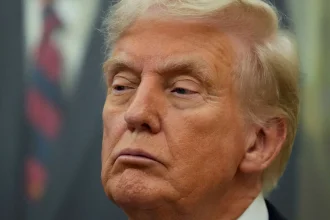China’s choke hold on rare earths — the minerals essential for electronics, automotive and defense systems — gives it significant leverage over the United States during ongoing trade talks.
Controlling about 60% of global rare earth production and nearly 90% of refining, China has once again tightened its grip by imposing export controls on seven rare earth elements and permanent magnets back in April.
The curbs, partly in response to sky-high tariffs on Chinese exports imposed by US President Donald Trump, were later eased to allow trade negotiations with Washington to proceed.
But on Thursday, China announced sweeping new export controls on rare earths, expanding curbs on processing technology and explicitly limiting exports to overseas defense and semiconductor users. The move further exposed US vulnerabilities, as the country lacks domestic refining capacity.
“The whole world economy relies on these magnets from China,” Jost Wübbeke, managing partner at the Berlin-based Sinolytics research house specializing in China, told DW. “If you stop exporting those, it will be felt across the globe.”
Resulting supply chain disruptions from earlier curbs have already hit American industries hard. US carmaker Ford, for example, announced in May it had been forced to scale back SUV production in Chicago due to shortages, while auto parts suppliers Aptiv and BorgWarner said they were developing motors with minimal or no rare earth content to counter supply constraints.
Rare earths are a critical component in electric-vehicle batteriesImage: Solomon Muche/DW
In June, Michael Dunne, a China-focused automotive consultant, told The New York Times that China’s curbs “could bring America’s automotive assembly plants to a standstill.”
US stocks could run out soon
A survey by the American Chamber of Commerce in China, conducted in May, revealed that 75% of US firms expect their rare earth stocks to be exhausted within months. US producers urged Washington to negotiate an end to the restrictions, and during trade talks in London in June, China agreed to speed up export license approvals, although a large backlog persists. Beijing’s latest export curbs threaten to reverse recent relief efforts.
China’s strategic use of rare earths as a geopolitical tool is not new. In 2010, Beijing halted exports to Japan for two months amid a territorial dispute, triggering price spikes and exposing supply chain risks.
Can the EU become raw material independent?
To view this video please enable JavaScript, and consider upgrading to a web browser that supports HTML5 video
Gabriel Wildau, managing director at New York-based CEO advisory firm Teneo, warned that China’s export licensing regime is a permanent fixture, not merely a response to Trump’s tariffs. In a note to clients in June, he wrote that “supply cutoffs will remain an ever-present threat,” signaling China’s intent to maintain leverage over Washington.
European industry also hurt by China’s curbs
The US is not the only economy impacted by the rare earth shortage. The European Union relies on China for 98% of its rare earth magnets needed for auto components, fighter jets and medical imaging devices.
The European Association of Automotive Suppliers warned in June the sector was “already experiencing significant disruption” due to China’s export curbs, adding that they had caused “the shutdown of several production lines and plants across Europe, with further impacts expected in the coming weeks as inventories deplete.”
Alberto Prina Cerai, a research fellow at the Italian Institute for International Political Studies (ISPI), told DW that Brussels urgently needed to “buy time.”
“In terms of scale, we [the West] cannot catch up with China,” he warned. “They have an integrated, mine-to-magnet supply chain that is very hard to replicate.” But while a complete decoupling from China is “unthinkable” in the short term, he said the EU should “manage this interdependence with a coherent industrial strategy.”
The European Commission, the bloc’s executive arm, aims to produce 7,000 tons of EU-based magnets domestically by 2030 under the Critical Raw Materials Act, with several mining, refining and recycling projects underway. A huge rare earth processing plant opened in Estonia this year, and another large facility in southwestern France will be operational in 2026.
Estonia hosts Europe’s largest and only industrial-scale rare earth separation facilityImage: DW
After meeting with his Chinese counterpart in May, EU Trade Commissioner Maros Sefcovic called China’s curbs “extremely disruptive” to Europe’s auto and industrial sectors. China did propose a “green channel” to expedite license approvals for EU firms, but experts warn that approvals could still take up to 45 days.
India cuts exports to boost domestic supply
Despite having the world’s fifth-largest rare earth reserves, at 6.9 million metric tons, India contributes less than 1% of the global supply of rare earths. The South Asian country lacks the refining capacity to process them for use in high-tech applications. India also relies on Chinese exports, which have also faced restrictions.
Although New Delhi has stepped up efforts to diversify its supply through deals with the US, Australia and Central Asian nations, progress has so far been slow.
In June, New Delhi ordered its state-run miner IREL to halt exports of the domestically produced minerals, including to Japan, to safeguard supplies for the country’s producers. In 2024, IREL delivered a third of the 2,900 metric tons of the rare earths it mines to Japan, via a Japanese processing firm.
G7 leaders vow to tackle China disruption
With China’s stranglehold unlikely to be rivaled anytime soon, G7 leaders meeting in Canada in June tentatively agreed on a strategy to anticipate critical rare earth shortages, vowing a joint response to deliberate market disruption, such as China’s, as well as moves to diversify production and supply.
“Recognizing this threat to our economies, as well as various other risks to the resilience of our critical minerals supply chains, we will work together and with partners beyond the G7 to swiftly protect our economic and national security,” the group of advanced economies said in a document titled the G7 Critical Minerals Action Plan.
Norway’s invisible rare earth mine
To view this video please enable JavaScript, and consider upgrading to a web browser that supports HTML5 video
ISPI’s Prina Cerai told DW that access to rare earths will become more critical for the West as advanced technologies emerge, noting how “robotics and humanoids might be an important market” in the medium term.
Several rivals ramp up rare earth production
After China’s 44 million tons of rare earth deposits, Brazil, India and Australia have the next largest deposits, collectively around 31.3 million tons, according to the US Geological Survey. Around 20 million tons were recently discovered in Kazakhstan.
The US and Australia are the most advanced in ramping up their own rare earth mining and processing output, while other countries’ plans are still in the early to mid-stages, requiring five to 10 years, environmental considerations and billions in investment.
Another future source could be Greenland, despite its harsh weather conditions. The US and EU have already signed cooperation agreements, and in 2023, the Tanbreez Project, in southern Greenland, was ranked as the top rare earth project by mining industry data provider Mining Intelligence, with an estimated 28.2 million tons of minerals.
But until alternative rare earth supplies are significantly scaled up, China will continue to wield this critical resource as a powerful geopolitical weapon, holding global industries and nations in its grip.
Wübbeke of Sinolytics is skeptical about whether other countries will ever tackle China’s stranglehold on rare earths due to the market leader’s huge cost advantage.
“Once China takes down export controls, prices will go down and the supply situation will ease. Nobody will talk about it [overreliance on China] again because then it’ll be about prices,” Wübbeke told DW. “Non-Chinese mines and refineries have to compete with these prices and normally they cannot.”
Edited by: Uwe Hessler
Editor’s note: This article was first published on June 11, 2025 and was updated on October 9 to reflect China’s latest rare earth curbs.


















